Molecular Interaction of Soluble Klotho with FGF23 in the Pathobiology of Aortic Valve Lesions Induced by Chronic Kidney Disease
- PMID: 38993571
- PMCID: PMC11234222
- DOI: 10.7150/ijbs.92447
Molecular Interaction of Soluble Klotho with FGF23 in the Pathobiology of Aortic Valve Lesions Induced by Chronic Kidney Disease
Abstract
Chronic kidney disease (CKD) is linked to greater prevalence and rapid progression of calcific aortic valve disease (CAVD) characterized by valvular leaflet fibrosis and calcification. Fibroblast growth factor 23 (FGF23) level is elevated, and anti-aging protein Klotho is reduced in CKD patients. However, the roles of FGF23 and Klotho in the mechanism of aortic valve fibrosis and calcification remain unclear. We hypothesized that FGF23 mediates CKD-induced CAVD by enhancing aortic valve interstitial cell (AVIC) fibrosis and calcification, while soluble Klotho inhibits FGF23 effect. Methods and Results: In an old mouse model of CKD, kidney damages were accompanied by aortic valve thickening and calcification. FGF23 levels in plasma and aortic valve were increased, while Klotho levels were decreased. Recombinant FGF23 elevated the inflammatory, fibrogenic, and osteogenic activities in AVICs. Neutralizing antibody or shRNA targeting FGF23 suppressed the pathobiological activities in AVICs from valves affected by CAVD. FGF23 exerts its effects on AVICs via FGF receptor (FGFR)/Yes-associated protein (YAP) signaling, and inhibition of FGFR/YAP reduced FGF23's potency in AVICs. Recombinant Klotho downregulated the pathobiological activities in AVICs exposed to FGF23. Incubation of FGF23 with Klotho formed complexes and decreased FGF23's potency. Further, treatment of CKD mice with recombinant Klotho attenuated aortic valve lesions. Conclusion: This study demonstrates that CKD induces FGF23 accumulation, Klotho insufficiency and aortic valve lesions in old mice. FGF23 upregulates the inflammatory, fibrogenic and osteogenic activities in AVICs via the FGFR/YAP signaling pathway. Soluble Klotho suppresses FGF23 effect through molecular interaction and is capable of mitigating CKD-induced CAVD.
Keywords: Chronic kidney disease; Klotho; YAP; calcific aortic valve disease; fibroblast growth factor 23.
© The author(s).
Conflict of interest statement
Competing Interests: The authors have declared that no competing interest exists.
Figures
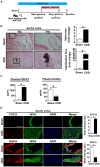
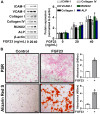
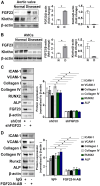
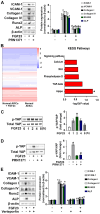
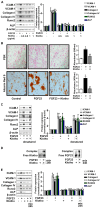

Similar articles
-
Klotho suppresses high phosphate-induced osteogenic responses in human aortic valve interstitial cells through inhibition of Sox9.J Mol Med (Berl). 2017 Jul;95(7):739-751. doi: 10.1007/s00109-017-1527-3. Epub 2017 Mar 22. J Mol Med (Berl). 2017. PMID: 28332126 Free PMC article.
-
Bone Morphogenetic Protein Signaling Is Required for Aortic Valve Calcification.Arterioscler Thromb Vasc Biol. 2016 Jul;36(7):1398-405. doi: 10.1161/ATVBAHA.116.307526. Epub 2016 May 19. Arterioscler Thromb Vasc Biol. 2016. PMID: 27199449 Free PMC article.
-
Mechanistic Roles of Matrilin-2 and Klotho in Modulating the Inflammatory Activity of Human Aortic Valve Cells.Cells. 2020 Feb 7;9(2):385. doi: 10.3390/cells9020385. Cells. 2020. PMID: 32046115 Free PMC article.
-
Fibroblast growth factor 23, klotho and heparin.Curr Opin Nephrol Hypertens. 2023 Jul 1;32(4):313-323. doi: 10.1097/MNH.0000000000000895. Epub 2023 May 4. Curr Opin Nephrol Hypertens. 2023. PMID: 37195242 Free PMC article. Review.
-
Klotho/FGF23 and Wnt Signaling as Important Players in the Comorbidities Associated with Chronic Kidney Disease.Toxins (Basel). 2020 Mar 16;12(3):185. doi: 10.3390/toxins12030185. Toxins (Basel). 2020. PMID: 32188018 Free PMC article. Review.
Cited by
-
Interaction Effect of Estimated Pulse Wave Velocity and Serum Klotho Level on Chronic Kidney Disease.Aging Med (Milton). 2025 Feb 20;8(1):e70005. doi: 10.1002/agm2.70005. eCollection 2025 Feb. Aging Med (Milton). 2025. PMID: 39981292 Free PMC article.
References
-
- Schiffrin EL, Lipman ML, Mann JF. Chronic kidney disease: effects on the cardiovascular system. Circulation. 2007;116:85–97. - PubMed
MeSH terms
Substances
Supplementary concepts
Grants and funding
LinkOut - more resources
Full Text Sources
Medical

